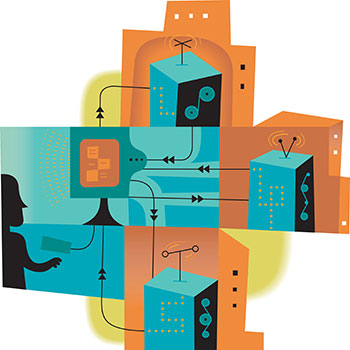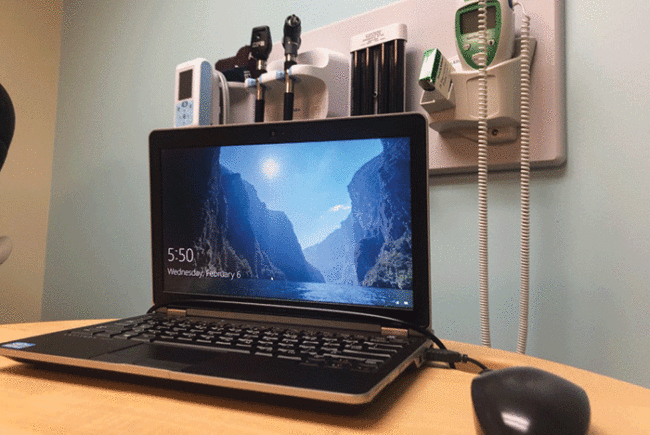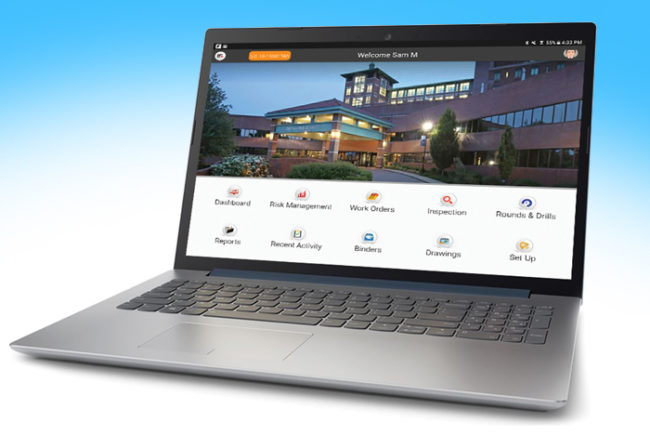 |
|
Illustration by Doug Ross/Illustration Source |
Most health care organizations have a mixed bag of infrastructure systems of various ages and brands, some of which may be obsolete and some of which may be the latest generation.
However, they have one thing in common in that they rarely communicate with one another and the ability to extract data often is inconsistent. Furthermore, they will not have data represented the same way, which inhibits building operators, engineers and facility staffs from unlocking the true potential of control and automation systems, and imposes penalties on the staff in terms of efficiency in performing daily operational tasks.
Such situations can be resolved by implementing an enterprise facility management (EFM) software system. An EFM system applies a consistent technology platform throughout a portfolio of buildings within an enterprise to manage data and information related to building systems that consume energy, such as HVAC and lighting.
With an EFM system in place, information can be visualized, measured, alarmed, compared, analyzed and reported in ways that drive activities to reduce energy consumption and cost. Further, it enables improved efficiency and productivity for the operations staff.
However, the keys to unlocking value in any EFM solution are people and process. Smart people with time and great technology but lacking a well-defined and continuous process to interpret and use the data most certainly will fail to achieve the desired outcome.
An EFM solution
An EFM platform can be used to measure and compare, benchmark and alarm virtually any data that matter to an organization. Without an EFM platform, data are located in silos of systems with no easy or consistent way to present and make the information relevant to users.
IN BRIEF |
| • Health care organizations are becoming responsible for a wide variety of building types run by a large assortment of infrastructure systems. • Problems arise when facilities professionals attempt to capture and compare operational data throughout a health care organization’s real estate portfolio because of their disparate buildings and systems. • An enterprise facility management software system can be used to extract equipment data from dissimilar operations to successfully manage overall organizational efficiency. |
Due to their diverse requirements, a health care system’s case for an EFM system is strong. Consider the following health care application requirements:
Building uses. These uses include critical care, isolation rooms, surgical suites, patient care, outpatient services, labs and offices.
Security requirements. This includes physical and cybersecurity.
Remote locations. As health care organizations continue to expand organically or through mergers and acquisitions, their numbers of locations, including many remote locations for clinics and urgent care, become more difficult to manage efficiently and effectively.
Energy intensity. By their nature, health care facilities are energy-intensive. Patient care is top priority and many systems are left operating in full-on mode to ensure no disruption to patient care. However, this comes at a steep price with regard to energy and operating costs, including equipment life. Implementing well-designed solutions that ensure high availability with no impact to patient care, while allowing systems to optimize their energy use, can reap significant benefits. But, the data must be available for this to be effective and EFM systems can enable this.
There are many subtle variations, but a sound EFM system starts with a layer of hardware and software that captures the data from various building automation systems (BASs), lighting systems, energy meters, water meters and other devices. Additionally, data from other systems, such as compressed air, medical gases, security, life safety, process equipment, lab equipment and fume hoods, also can be brought into the EFM system, if desired.
You may also like |
| Infrastructure planning for offsite operations |
| Considerations for hospitals as landlords |
| Adapting legacy properties for population health |
| |
The reason for this layer of hardware and software is that BASs, lighting and other systems in a building vary widely in terms of their age, the way they communicate, the accessibility of their data, and how the data are represented (i.e., named, tagged, etc.). For applications and users of the system to make use of data in meaningful ways, data should be normalized. In other words, data should be made to look and behave the same from system to system and building to building.
Normalizing the data in a common platform allows the following:
Visualization. Data can be viewed in many forms, including dashboards, real-time operator displays, video walls and presentation screens, mobile devices and others.
Alarms. The platform can provide alarms, prioritization and escalation in a common fashion so that operators and users have a consistent way to process and properly respond to alarms.
Scheduling. The platform can set schedules using a consistent method for building occupancy, equipment operation, lighting control, security access and other systems. This aids in understanding and usability and reduces the learning curve for operators.
History. The platform can log data in a consistent manner based on the type and nature of the data. EFM systems provide a common platform for storage, archiving and retrieval that enables simplified reporting and data management.
Control. In some cases, EFM systems can provide a common method to provide supervisory control, such as setpoint adjustment, manual override, demand-limiting and/or demand-response control sequences and optimum start. The benefit is that operators do not need to learn multiple systems to perform common tasks, thereby reducing the learning curve and improving operator efficiency. This also provides a way to perform commands for multiple systems in multiple buildings, whether on a campus or across one or more geographic regions, with a single command.
Data into solutions
With data from various buildings and their systems and devices in a common platform and normalized, it is then possible to add applications to analyze the data in ways not available as few as five years ago. Analytics applied to building system and meter data allow the development of algorithms or rules that become the eyes and ears of the building. This technology is looking for anomalies and patterns that become leading indicators of faults on systems and devices or processes out of tolerance and more.
There is a common misconception that analytics in and of itself will save money. In reality, analytics will not save money. First, it is not about the technology, but rather about people and process. Technology is merely the enabler. Second, analytics is a tool and not the remedy.
There is a dizzying array of EFM products on the market today and all claim to do the same thing. However, frequently lacking in discussions of analytics is the importance of people and process to achieve a successful outcome.
The following are key points that have little to do with technology, but are critical to successful results:
Budget. How much money is allocated for corrective action? This may seem obvious, but all the money spent on analytics will not return a penny to the bottom line if the issues identified are not actually addressed. It is frequently assumed that simply implementing an analytics solution will produce results. If an organization’s maintenance strategy is run to failure, it is virtually impossible for any analytics solution to achieve the desired results. Sufficient money and resources must be allocated to correct the issues identified by the solution.
Process or workflow. Corrective action needs to be implemented in the context of a clearly defined process. The key to a successful implementation that is aligned with an organization’s budget and resources is to build a process around the technology. The ultimate solution is built around a process that effectively triages, prioritizes and ultimately corrects the issues that have the greatest impact on the organization’s bottom line without placing an undue burden on its budget and resources. It is often stated that more data are better, more rules are better and so on. However, more is not always better if it does not align with the organization’s ability to process it or return value sufficient to offset the cost to obtain it.
Prioritization and cost impact. There are a number of methods for prioritizing the issues identified by an analytics solution, including frequency or length of the fault condition, cost impact of the fault and the importance of the area served by the equipment associated with the fault.
Frequency and duration are easily understood and easy to quantify. However, cost impact is another story. There are too many variables that influence cost and impact value. For example, consider an economizer failure. To have an accurate cost-impact value requires users at least to consider equipment age and condition, climate zone, hours of operation, energy cost and type of occupancy. For a single-site implementation, this may not seem too difficult and would only need to be tailored for each asset to which the rule applies. However, when implementing this rule across hundreds of sites, the effort required to capture and input the data is formidable.
An effective approach in these situations is to apply some level of generalization. This provides reasonable accuracy for the time required to set up the data. Are they completely accurate for each piece of equipment? No. However, keep in mind that the data are being used to prioritize corrective actions, not to predict absolute cost avoidance.
Corrective action. Once prioritized, how are corrective actions implemented? Typically, they will fall into one of three buckets. Immediate action items are those that are both urgent and important. Scheduled items are those that are important, but not necessarily urgent. Finally, other corrective action items can be aggregated together to form more strategic improvement projects. Regardless of the approach, it is imperative that the corrective action process keep pace with the issues identified.
In the initial deployment, one would expect to find many issues. The rules provide a broad view of the portfolio, building and assets. As issues are identified, prioritized and corrected, focus becomes more concentrated. Simply put, one moves away from looking at the easy-to-identify problems to searching for less obvious ones. If the process fails to correct the obvious, the less obvious problem will never be found and efforts will be stymied. This is one of the primary purposes of the process — to throttle the number of issues to a level that is consistent with what the organization can handle from a staffing or budget availability standpoint.
The budget must provide for both the analytics solution and corrective action. It is straightforward to establish a budget for implementing the analytics solution. However, consideration also must be given to budgeting for continuous corrective action and the level of throttling that needs to take place to make the overall process sustainable. Identifying more than can be corrected is of little value and ultimately can be counterproductive.
Current condition. What is the current condition of the equipment, and is there an active program for maintenance and improvements? Once the analytics solution is implemented, what is it likely to find? A building or portfolio of buildings whose equipment is well-maintained, and has an established replacement cycle, likely will result in fewer major issues discovered by the analytics.
However, applying analytics to equipment that has not been properly maintained likely will result in significant findings that will include major repairs. This needs to be considered when planning an analytics solution because the findings could be overwhelming. While these are excellent situations for analytics and the opportunity for meaningful results is significant, there needs to be a clear understanding that the problem was not created overnight and it will not be corrected overnight.
Implementing analytics should be done with the understanding that analytics is not a discrete project. Rather, it is a continuous process where issues are identified and corrected in a prioritized manner, within the limits of staff and budget. When tasks are completed, another level of issues is identified and addressed. As each successive layer is resolved, the process narrows its focus and moves to a greater level of detail. This continues to drive more efficiency and, ultimately, cost savings.
Powerful tool
Technology without skilled people to interpret it and a well-defined process to prioritize, correct and track the issues, will not yield successful outcomes.
However, when applied and managed correctly, an EFM system will not only identify day-to-day issues, but also may serve as a powerful tool to assist in capital purchasing decisions and comparative analyses across the enterprise.
Paul Oswald is managing director at CBRE/ESI in Brookfield, Wis. He can be reached at paul.oswald@cbre.com.
Selecting the right EFM system
Because of such variables as age, location, equipment, systems, maintenance and occupancy, no two health care building portfolios are alike. To determine which enterprise facility management (EFM) software system meets the needs of an organization, a site-readiness assessment should be conducted to ensure that building performance is maximized. Whether conducted by an internal team or an outside consultant, the following actions should be included in such an assessment:
• Conduct facility staff interviews. Interview the facility engineer to understand the control system capabilities, determine remote access capability, uncover any known issues and obtain an overview of the facility equipment.
• Conduct a building automation system (BAS) review. This includes an analysis of the existing facility automation system architecture and integration capabilities, including system details such as make, model, software version and remote accessibility; documenting system capabilities and limitations of proprietary applications being used such as BACnet, LON, and Modbus; identifying which equipment is currently being controlled; downloading and saving a points list and gathering screen captures for equipment like air-handling units, pumps and typical terminal devices; and determining the site-integration and data capture plan.
• Conduct a facility equipment readiness assessment. This includes the mechanical equipment inventory taken from information gathered during the BAS review and all major fixed equipment. Motor nameplate data also should be reviewed and collected for major pieces of equipment.
• Assess utility meters. This includes collecting information about the main facility’s electric, gas and water meters.
• Rule checks. Review and determine which analytic rules will be applied to the buildings and equipment based on type of assets; available points, sufficient to support the rules; and interviews with the facility engineers to determine history, operation and applicability.





